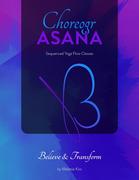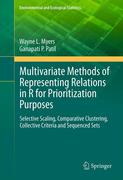50 Results for : sequenced
-

ChoreogrAsana
ChoreogrAsana - Sequenced Yoga Flow Classes: ab 11.65 €- Shop: ebook.de
- Price: 11.65 EUR excl. shipping
-

Multivariate Methods of Representing Relations in R for Prioritization Purposes
Multivariate Methods of Representing Relations in R for Prioritization Purposes - Selective Scaling Comparative Clustering Collective Criteria and Sequenced Sets: ab 138.99 €- Shop: ebook.de
- Price: 138.99 EUR excl. shipping
-

Graphics-sequenced interpretation of ECG
Graphics-sequenced interpretation of ECG: ab 53.49 €- Shop: ebook.de
- Price: 53.49 EUR excl. shipping
-
Displaced Soundtracks (2LP)
Unter der Ägide von DJ Tennis zeigen die besten zeitgenössichen House-Produzenten ihre verborgenen Talente als Soundtrack-KomponistenUnter der Ägide von DJ Tennis zeigen die besten zeitgenössichen House-Produzenten ihre verborgenen Talente als Soundtrack-Komponisten. Feat KinK, Stimming, Alex Boman, Appleblim, Redshape u.v.a. Seven years into its celebrated journey, Life and Death assembles its third and most adventurous compilation to date - Displaced Soundtracks. For the first instalment in a new series, DJ Tennis has given free rein to some of his most trusted contemporaries, enabling many of today s most respected dance music producers to display their hidden talents as composers. Gathering music from a long-aborted film, the collection stands as another bastion of Life and Death s perpetual evolution. Duncan Gray embraces dissonance, Black Merlin, Appleblim and Artefakt go interstellar and Fango channels post-punk squat music. Hades Rocket showcases the expertly-sequenced synth work that has graced Simian Mobile Disco s illustrious career, while Redshape revisits all the right sides of 80 s Wave and Library music. Danny Daze and synth-savant KINK embrace non-standard tempi with great success, while Axel Boman delivers sitar-laced gospelhouse without a bass drum. Elsewhere, your favourite producer s favourite producer, Stimming, team s up with pianist Lambert and the pair learn to fly. Inspired and challenging, Life and Death ventures into their eighth year confidently, constantly evolving without compromise. TRACKS: A1 Artefakt Magnetic Midnight A2 Black Merlin OPI A3 Appleblim Sacred Rowan Grove B1 Stimming x Lambert Trafic Aeìrien B2 Kink Megadrop B3 Fango Nung C1 Axel Boman Just Imagine (Part I & II) C2 Duncan Gray Smelly Little Man D1 Simian Mobile Disco Hades Rocket D2 Redshape Theme D3 Danny Daze Orb- Shop: odax
- Price: 33.78 EUR excl. shipping
-
Die späten Aufnahmen Vol.3-1949-51
"Chopin is the focus of volume 3, recorded between 1949 and 1951. APR has sequenced the works in such a way that the Nocturnes, Preludes, Waltzes and Etudes run in sets, even when recorded at different sessions. ..." (Music Web International)- Shop: odax
- Price: 7.35 EUR excl. shipping
-
-
Caravan
Composer Tim Story follows up his critically-acclaimed collaboration 'Lunz' with a soundtrack from another part of the world. From the production company of award-winning Spanish director Pedro Almodovar, Caravan is a feature-length documentary set in Nepal and north Africa. A unique glimpse into two seldom-seen cultures, the film traces the compelling journeys of two adolescent boys: Pemba in Nepal, and Rabdoulah in Niger. Each will embark on an adventure that few of us Westerners will ever experience -the centuries-old salt caravans. For followers of Tim Story's elegantly introspective 'ambient chamber' music, Story might seem an unconventional choice to score a film set in such exotic locales. Steadfastly evolving his own unique palette of Western classical instruments and subtle electronics, Story was never seduced by the 'world music' flourishes that have become so commonplace. But as Caravan's music supervisor Alán Cantos enthused, 'I saw a thousand adventures, dunes, sky, stars, and empty spaces... and I was only two-thirds into {Tim's} first CD!' Discovered one day on a Madrid radio station, Story's music had stayed with Cantos, prompting him to share it with Caravan's director Gerardo Olivares during one of the film crew's shoots in Niger. It became a kind of soundtrack for their long days and nights in the desert. When the time came for the filmmakers to commission a composer to score the film, the choice was already becoming clear. There are the occasional geographic cues in Story's music for Caravan: the tongue drums deftly played by Louie Simon, the oriental flute in one piece, or the chants of Tibetan Buddhist monks in another, all of which conjure for the listener a vivid sense of time and place. But this soundtrack is no world music travelogue. Caravan is a film about people, and Story's music searches for the nuances and truths of human nature. Always a particular strength of Story's solo work, moments of sheer beauty and unsettling dangers intermingle in this music, deepening the film's tone with uncommon delicacy. Beautifully articulated by Kim Bryden's oboe and Martha Reikow's cello, Story's spare yet rich themes map for us the emotional terrain of Pemba and Rabdoulah's journeys, and in doing so, give us a recording that is strikingly haunting and surprisingly cohesive - even when removed from the context of the film itself. Remixed, re-sequenced and in some instances even re-composed for this CD release by Story himself, Caravan shows clearly why the Grammy-nominated composer has been called 'a master of electronic chamber music' (CD Review, USA), and 'a true artist in the electronic medium' (Victory Review, USA).- Shop: odax
- Price: 28.18 EUR excl. shipping
-
Xclassics
XClassics 'By inserting the variable 'X' into a classical music equation we can extend the music's traditional identity, and establish the very transformations that define it's character.' - Brian Slawson, composer and percussionist Liner notes for Brian Slawson's XClassics Slawson, a virtuoso percussionist, has a musical style evolved from the contemporary sounds of jazz, rhythm and blues, island, world and pop music. His compositions start with music written by great masters and he transforms them through the organic sounds of percussion and the high technology of the latest digital sounds. 1) Galactica Influence: Felix Mendelssohn's Fingal's Cave, also known as the Hibredes Overture. Arranged with space exploration in mind, Galactica could serve as the perfect musical 'wake up call' to NASA astronauts. 'My personal challenge was to create a clear, penetrating yet floating vibraphone tone that was capable of delivering a melody surrounded by sequenced electronics. I feel that Galactica, in and of itself, purely defines the whole of the XClassics concept.' 2) Once Upon A Time In America Influence: Allegretto from Beethoven's Symphony #7 After the tragedy of September 11 Brian felt the need to depict the events in his own 'words'. Once Upon A Time In America, based on the stunning Allegretto from Beethoven's Symphony #7, is intended to connote the surreal manifestations generated by my overwhelming feelings of disorientation. The top of the track gives a sense of free-falling in a spinning, echo-laden environment. 'To humanize the special effects I triggered a variety of moaning sounds, most of which are whale samples. Then, to sustain a level of discomfort and forward motion, I introduced a funky, unorthodox hi-hat loop. At this point, the dichotomy which defines this track is in place: the rhythmic comfort zone that we know as common time versus the unpredictable and disturbing tones that support the melody,' says Slawson. As the track builds, the tune is doubled on bagpipes while Scottish drums and Latin percussion instruments (ironically quoting Arabic rhythmic figures) are woven into the fabric -- reminiscent of a police officer's or fire fighter's funeral procession. In the final verse Beethoven's original string arrangement is preserved, while set in motion by powerful orchestral crash cymbals and an ear-splitting backbeat from the snare drum. After the final plea from the soaring strings reaches a climax, a repetitive outro ensues. 'As the track fades, electronic 'frying' sounds and haunting tuned gongs deliver the final death motif engulfed in a disturbing concrete block reverb. A symbolic dogfight persists in the deserted war zone that is forever...' says Slawson. 3) Vibe Island Influence: Mozart's Symphony #40 One listen to Vibe Island and Mozart's impact on popular music becomes clear. After Slawson heard one too many cell phone rings, Vibe Island was born. The opening melody to Mozart's Symphony #40 is a phone call waiting to be answered, but who says it can't be a one-way ticket to the islands? 'Mozart's tune is brilliant and simple,' says Slawson. 'But I also needed to honor the development, which he typically seems to travel through effortlessly. The development crescendos to a stop time, pipe organ climax ... (dramatic pause) ... followed by a playful 'pseudo jazz' vibe solo?!! If musical jokes were a crime I would've been locked up a long time ago, not to mention Mozart,' says Slawson. 4) Symphony in Blue Influence: Adagio from Tchaikovsky's Symphony #4 A Miles Davis approach transform a 'legit' tune into a Real Book favorite. 'The Adagio from Tchaikovsky's Symphony #4 seemed a suitable choice to try out this approach, and a nice tune to blow (improvise) on,' says Slawson. 'After attempting a multitude of juxtapositions, I settled on subtle rhythmic changes only to the melody. Sometimes the slightest alterations have the greatest overall impact.' 5) New Worlds Influence: The Finale from Tchaikovsky's Symphony #4 and excerpts from Dvorak's New World Symphony Two completely different works and original material, connected by good old fashioned backwards guitar and smash mouth percussion. The Finale from Tchaikovsky's Symphony #4 and excerpts from Dvorak's New World Symphony provided plenty of options for exploration. 'I created a shout chorus and some release material that helped to connect the source excerpts. The rest is good old fashioned backwards guitar and smash mouth percussion,' says Slawson. 6) Tales of the New Frontier Influence: Bach's Polonaise from Orchestral Suite #2 'I wonder if Bach ever considered that his music might one day be suitable for planetariums?' Tales of the New Frontier is a simple study of depth through mixing and mastering and movement through space. 'The more preoccupied I became with sound and effects placement, the further I strayed from Bach's original work,' says Slawson, who broke out his bag of percussive tricks. 'I placed cymbals bell side down on top of a timpani and softly rolled on the outer edges with felt mallets while operating the tuning pedal, all the while changing the depth of field between the microphone and the instruments.' 7) Rockbox Influence: Bach's 2-Part Invention in F Major 'Lay down some Bach-style counterpoint on marimba and vibes, add some 50's retro chord changes, a cheesy Casio and a dash of disco drums, and you've got Rockbox,' says Slawson. Slawson's recordings have often been used to introduce young people to classical music. The linear, often rhythmic structure of Baroque counterpoint, performed on playful mallet instruments, is evocative of a massive music box. 8) Flydog Influence: C.P.E. Bach's Solfeggietto Slawson says, 'Just before I began tracking Flydog, I was hired to produce a boy band in Miami. Suffice it to say, I had never been accused of being a consumer of such music! In order to prepare for the sessions, I purchased a couple of recordings that best represented the target demographic. One happened to be an Eminem CD produced by Dr. Dre. What would a tune inspired by C.P.E. Bach's Solfeggietto sound like, arranged and produced by Brian Slawson in the style of Dr.Dre?' C.P.E. Bach is one of the many musical sons of Johann Sebastian Bach. 9) Requiem For An Industrial Age Influence: Mozart Requiem As the twentieth century came to a close, a new dawn was on the horizon. 'Years ago I toured through Pittsburgh, which had been hit hard by layoffs in the steel industry. The city stood still, desolate, and crippled by a ravaged economy. The sounds and smells of a truly depressed metropolis had a remarkable feel to it,' recalls Slawson. The Industrial Age had given way to technology. 'I wanted to create a somber tone, one that took me back to those days in Pittsburgh,' says Slawson. 'The opening to the Mozart Requiem offered a perfect bed on which to adorn isolated, disturbing sounds of clanging pipes and anvils.' The music soon offers hopeful glimpses interspersed with industrial sounds until, finally, a raucous chorus and a triumphant coda disperse the waste and leads us into the new day.' 10) Gypsy Train Influence: Brahms' Hungarian Dance #5 Dvorak's Slovakian Dance #7 Bach's E Minor Bouree Bach's Goldberg Variations A schizophrenic assemblage of four different tunes by three different composers ... After a Santana-like intro, Brahms's famous Hungarian Dance #5 kicks off it's shoes. The tune that appears between the verses is Dvorak's Slovakian Dance #7. After the Hungarian Dance chorus, in steps Bach's E Minor Bouree, which is a French dance?! The cadenza (breakdown) features a melodic quote from Bach's Goldberg Variations until... you guessed it ... back to the Slovakian dance. 'This ain't no Macarena!,' says Slawson. 11) Abyss Influence: 16th Century Chant Abyss is based on a sixteenth century French chant that later resurfaced in an arrangement by Gustav Holst. 'Many have said that recording media are primarily about capturing moments in time,' says Slawson.- Shop: odax
- Price: 22.98 EUR excl. shipping
-
Stellar Moments
In a recent conversation, Dale Fielder mentioned that he was a musician. When asked what instrument he played, he answered without hesitation, "I play all four saxophones." Over his recorded career, it is hard to pen down which saxophone is Fielder's primary instrument or which one he sounds best on. He plays them all equally well. He has displayed them all throughout thirteen recordings starting in 1993. Most recently, he has concentrated on the baritone sax through his last three recordings: Howling Monk (2003), Baritone Sunride (2005) and Plays The Music of Pepper Adams (2007). On this new recording, Stellar Moments, Fielder plays no baritone and concentrates the bulk of the material on the tenor sax, also performing two compositions on soprano and one on alto. Fielder also has a penchant for finding new or unheard jazz talent. He brought back the legendary ex-Mingus pianist Jane Getz from obscurity and introduced pianist Danny Grissett who is now with Tom Harrell and taking NYC by storm. Here in his new group, Angel City Quartet, he introduces another considerable jazz talent in pianist Greg Gordon Smith. And along with bassist Bill Markus (who looks and sounds like the late Albert Stinson) and the ubiquitous Thomas White on drums, Angel City Quartet sounds like a tight, cohesive ensemble that belies the fact that they have only been together just over a year. They play like a band, not like a collection of separate individuals just getting through the session like a day at the office. There's a lot of passion here. The music contained in Stellar Moments flows like a movie soundtrack as it is sequenced much like a suite. The first three compositions are from Fielder's own pen. From the opening bars of the title cut, you can tell that this is not your father's jazz! The shifting 7/4-4/4 composition is a most exciting 4:30 minutes of jazz! It flows into the trance-like The Quickening where Fielder makes his only appearance on alto conjuring up Bird meeting Trane in an impassioned solo. The loose interplay of the rhythm section during Smith's solo is sublime. Next is the elegant Patricia's Flow, a 7/4 ballad where Fielder introduces his tenor. Next up is an intelligent and swinging rendition of the Joe Henderson classic, Punjab followed by the sprightly, danceable Fielder bossa original, Escapade With Ese, which incidentally has an affectuous melody. Wayne Shorter's Yes And No is certainly a standout composition that should see quite a bit of airplay. Fielder's re-arrangement gives it a 'Maiden Voyage' rhythm which gives this tune a definite contemporary flavor. The standard The Night Has A Thousand Eyes is given a straight down the middle straight-ahead jazz treatment with White displaying some deft brush work. Fielder's sensuous writing is displayed on Mulu, a 6/8 Latin tune that again features White. The closer is Thelonius Monk's I Mean You, where Markus opens the soloing with an incredible arco solo. Dale Fielder is an anachronism. Yet he sounds thoroughly modern and up to date. One can imagine Fielder on the bandstand comfortably sidling up next to a Kenny Dorham or Art Farmer as his sound is classic. Fielder himself has said that of all the saxophonists currently playing, he feels more in common with saxophonist Scott Hamilton. Perhaps this is because Fielder is also a product of the 1970s, the so-called lost generation that spawned such other underrated sax greats such as Billy Harper, Bobby Watson and Bennie Maupin. In any event, Stellar Moments should go a long way to bringing Fielder closer to the recognition he so rightly deserves. This for the simple fact that so few are unabashedly and unapologetically pursuing this type of modern, updated, straight-ahead jazz today. Most of today's current artists attempt to distance themselves from traditional jazz and seek a fusion with other world music influences. They do so in an attempt to be considered 'contemporary' because traditional or straight ahead jazz has been judged old fashioned. Yet here in Stellar Moments, while embracing the tradition, Fielder sounds completely contemporary. Fielder has been quoted as saying that he is not ashamed of the word jazz. Thank God for that!- Shop: odax
- Price: 23.16 EUR excl. shipping
-
Poètes Du Piano-live Recital
Poètes du Piano is the perfect description for this beautifully sequenced selection of Romantic piano pieces, a series of exquisite miniatures by the likes of Chopin, Ravel, Fauré and Poulenc, in which delicacy and brevity are prized over the more prosaic charms of full-scale works (The Independent, 18.6.2010).- Shop: odax
- Price: 15.90 EUR excl. shipping






